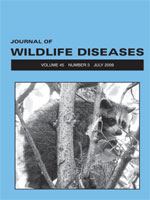We documented the antibody prevalence to three arboviruses, St. Louis encephalitis virus (SLEV), eastern equine encephalitis virus (EEEV), and West Nile virus (WNV), in Crested Caracaras (Caracara cheriway; n=80) in Florida from 2007 to 2008. Antibody prevalence to WNV was higher (9%) than for the other viruses. Most seropositive birds were adults (≥3 yr of age), with 55% of adults testing positive for antibodies to at least one virus. Adults were significantly more likely to have antibodies to WNV than nonadults (P<0.001). Prevalence of SLEV and EEEV antibodies among Crested Caracaras was 3% for each virus, and three adult caracaras had indistinguishable anti-flavivirus antibodies. The susceptibility of Crested Caracaras to adverse effects of WNV, SLEV, or EEEV infection remains unknown; however, we observed that some free-ranging individuals survived infection and successfully fledged young. Knowledge of arboviral infection among Florida’s Crested Caracara, which is both state and federally threatened, is valuable considering increasing pressure on this population from rapid and extensive habitat alterations.
How to translate text using browser tools
1 July 2009
Prevalence of Antibodies to West Nile Virus and Other Arboviruses among Crested Caracaras (Caracara cheriway) in Florida
Nicole M. Nemeth,
James F. Dwyer,
Joan L. Morrison,
James D. Fraser

Journal of Wildlife Diseases
Vol. 45 • No. 3
July 2009
Vol. 45 • No. 3
July 2009
antibody
Caracara cheriway
Crested Caracara
Eastern Equine Encephalitis virus
seroprevalence
St. Louis encephalitis virus
West Nile virus




